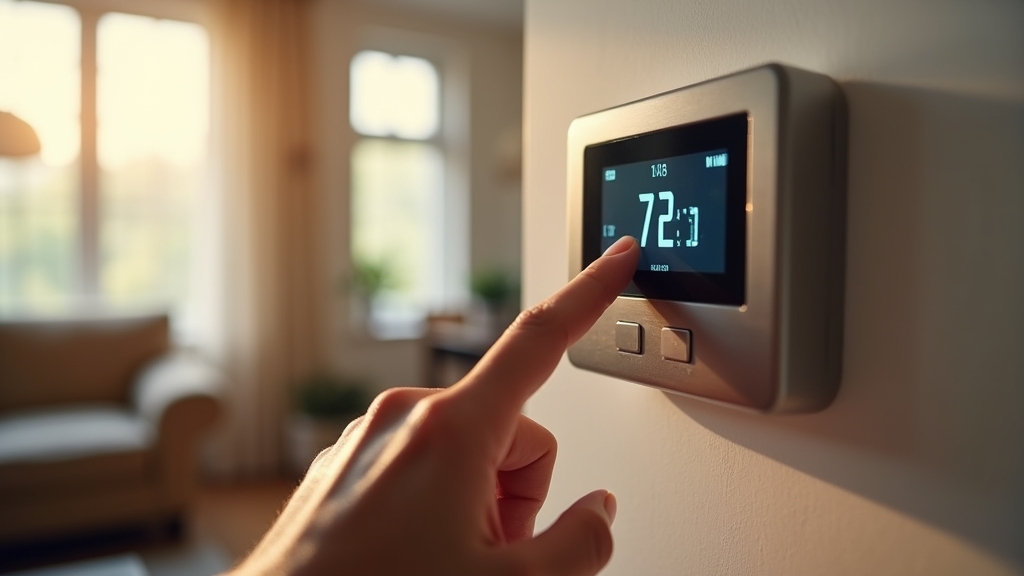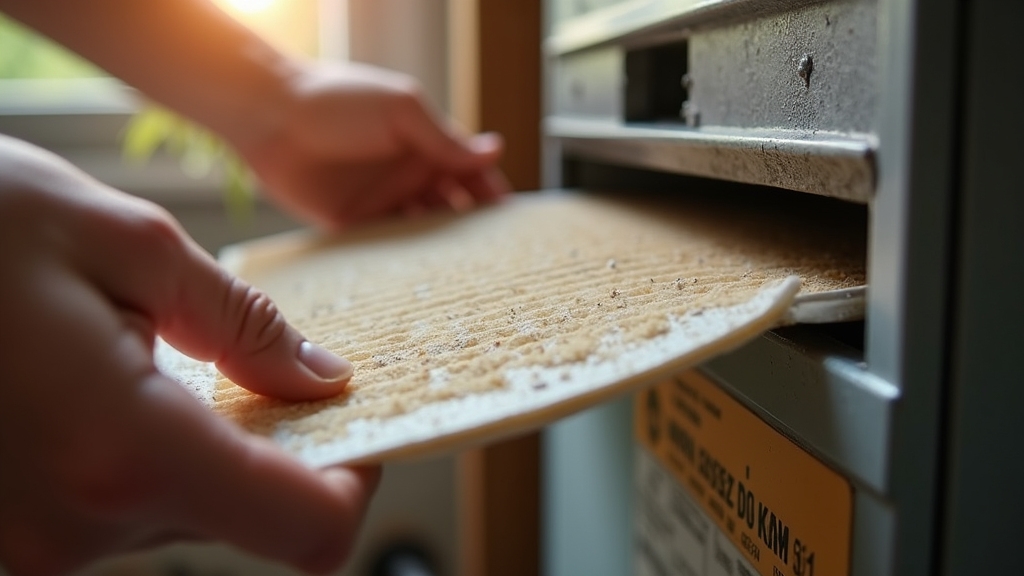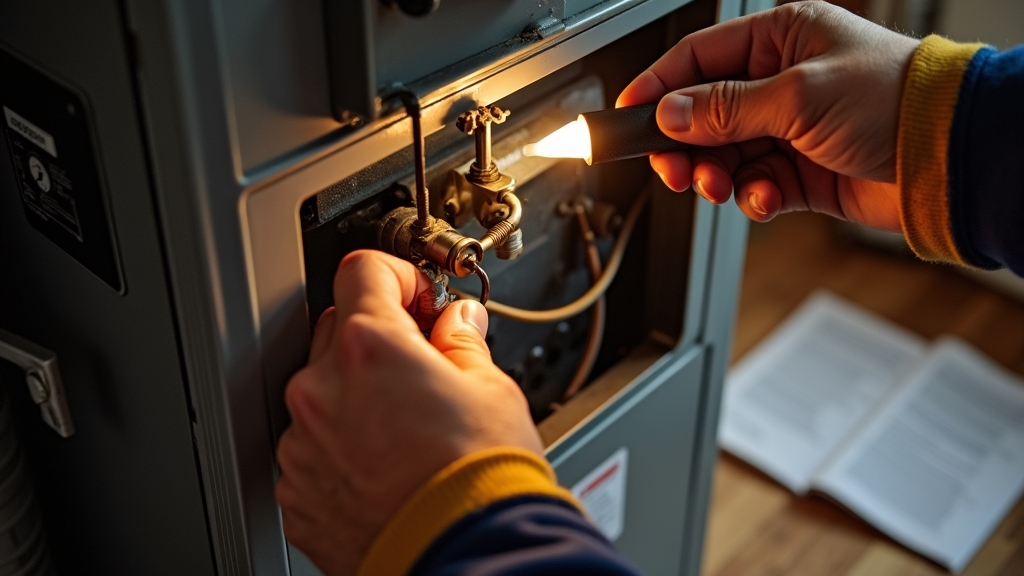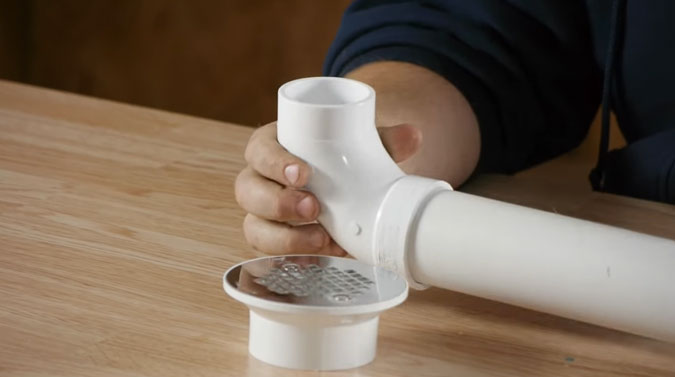If your furnace stops working, first check that your thermostat is set to “Heat” and above room temperature. Confirm power by inspecting circuit breakers and the furnace power switch. Replace dirty air filters to guarantee airflow. Examine the ignition system for a lit pilot or glowing ignitor.
Inspect the blower motor and belts for damage. Smell for gas leaks and listen for unusual noises. If problems persist, a professional technician may be needed. Further troubleshooting can reveal detailed solutions.
Key Takeaways
- Verify thermostat is set to “Heat” mode and temperature is above room temperature to activate the furnace.
- Check power supply, circuit breaker, and furnace switch to ensure the unit is receiving electricity.
- Inspect and replace dirty or clogged air filters to maintain proper airflow and system efficiency.
- Examine ignition components, pilot light, and gas supply for blockages or malfunctions preventing ignition.
- Listen for unusual noises or odors and call a professional HVAC technician if issues persist or gas leaks are suspected.
Check Your Thermostat Settings

Before troubleshooting your furnace, make sure your thermostat is set correctly. Set it to “Heat” mode rather than “Cool” or “Off” and adjust the temperature higher than the current room temperature to guarantee the furnace activates as intended. Regular maintenance and inspection of furnace components, similar to disassembling a submersible pump, can prevent unexpected breakdowns.
If your thermostat is on “Auto” mode, switch to “Heat” to ensure manual temperature adjustments directly trigger the furnace. Check for programmed schedules that may override manual settings; temporarily disable them to test furnace response.
Inspect for a lock icon on the display indicating restricted adjustments. Unlock it following your thermostat’s instructions. Proper thermostat placement is vital; avoid locations near heat sources, drafts, or direct sunlight that cause inaccurate readings and disrupt furnace cycling.
If your thermostat uses batteries, check and replace them regularly to prevent power issues that can affect furnace operation. Correct these settings and placement to ensure your furnace operates efficiently.
Verify Furnace Power Supply
After confirming your thermostat settings are correct, the next step is to verify that your furnace is receiving power. Start by checking the furnace power cord is firmly plugged into a live outlet; test the outlet with another device or voltage tester. Installing a backup power source can help maintain furnace operation during power outages.
Next, locate the furnace circuit breaker in your main panel. Ensure it’s not tripped and reset it if necessary. Then, inspect the furnace power switch near the unit. Confirm it’s in the “on” position and test for continuity if needed.
Before troubleshooting further, power off furnace to ensure safety and prevent any electrical hazards during inspection. Finally, examine the internal control board’s power by measuring voltage at its terminals. Check for indicator lights or error codes.
Inspect and Replace Air Filter

You should regularly check your furnace air filter for dirt, discoloration, or damage to guarantee ideal airflow and system efficiency. Before replacing the filter, turn off the HVAC system to ensure safety and prevent debris from entering the unit.
Replace the filter according to manufacturer guidelines or sooner if you notice restricted air movement or heavy debris buildup. When installing a new filter, align it with the airflow direction indicated and secure it properly to maintain proper furnace operation.
Make sure to use a filter with the correct wire gauge rating if your furnace setup involves an extension cord to prevent electrical issues.
Check Filter Condition
A furnace filter plays a critical role in maintaining efficient airflow and protecting your system from dust and debris. To check the filter condition, inspect it carefully for visible signs of clogging, damage, or mold. A dirty or damaged filter will restrict airflow and reduce heating efficiency, potentially causing the furnace to overheat or short cycle.
They also protect internal HVAC components from debris buildup, which helps reduce the risk of system malfunctions. Poor air quality caused by inadequate filtration can exacerbate respiratory issues similar to those caused by exposure to harmful pathogens.
Follow these steps to assess your filter:
- Look for gray discoloration and dust accumulation on the filter media.
- Check for tears, holes, or visible mold growth on the filter surface.
- Notice any increased dust near vents or musty odors indicating poor filtration.
- Evaluate if airflow feels weak or uneven heating occurs throughout your home.
Filter Replacement Frequency
Inspecting the filter condition regularly helps determine when to replace your furnace air filter. Replacement frequency varies by filter thickness and type: 1- to 2-inch filters need changing every 1 to 3 months, 3- to 4-inch filters last 6 to 9 months, and 5- to 6-inch filters can go 9 to 12 months.
HEPA filters require annual replacement if they’re non-washable. Environmental factors like pets, allergies, dust, and smoking speed up clogging, requiring more frequent replacements. Neglecting filter changes reduces airflow, raises energy use, shortens furnace lifespan, and worsens air quality.
The EPA recommends inspecting filters monthly during heavy use and replacing them at least every 90 days. Always change filters when visibly dirty and follow manufacturer guidelines to keep your system running efficiently.
Regular filter replacement also helps prevent system clogging and damage, improving both indoor air quality and HVAC efficiency. Additionally, maintaining proper installation of furnace components ensures optimal operation and longevity.
Proper Filter Installation
Although proper filter installation may seem straightforward, ensuring correct placement and orientation is critical for maintaining furnace efficiency and indoor air quality. You must install the filter media box between the return air plenum and air handler box, ensuring the filter housing is accessible and sealed to prevent air leaks.
Proper sealing is essential to avoid issues similar to those caused by air leaks in pumps. Align the filter arrow with the airflow direction toward the furnace blower to avoid reduced effectiveness and potential damage. It is best to replace the filter when the furnace is off to ensure optimal airflow and safety. Follow these steps:
- Locate the filter behind the furnace panel or return duct, removing covers carefully.
- Remove the old filter gently and slide the new one fully into the slot without forcing.
- Seal gaps using magnetic strips or tape to inhibit unconditioned air infiltration.
- Use MERV-11 rated filters sized precisely per ACCA Manual D standards for ideal performance.
Examine the Ignition System and Pilot Light

When your furnace fails to ignite, start by examining the ignition system and pilot light, as these components are critical for initiating combustion.
First, identify your ignition type—standing pilot, intermittent pilot, or hot surface ignitor—and check if the pilot light is lit or the ignitor glows or sparks. Regular maintenance can help prevent ignition issues caused by buildup or wear.
Determine your ignition type and verify if the pilot light or ignitor is functioning properly. Inspect for dirt, drafts, or blockages obstructing gas flow. Ensure that the gas line is clear and unobstructed, as a blocked gas line can prevent proper fuel flow to the furnace.
Assess the flame sensor or thermocouple for debris that may shut off gas as a safety measure. If issues persist, professional inspection is advised. It is important to understand the safety precautions involved in handling furnace components to avoid hazards.
Assess Furnace Blower and Related Components
Start by inspecting the blower motor for signs of wear. Ensure the shaft spins freely without wobble or resistance. Check the belt for cracks, proper tension, and alignment to maintain efficient blower operation. Remove any debris or dirt from the blower wheel to prevent airflow restrictions and mechanical imbalance.
Additionally, locate and press the red reset button on the motor if popped to reset the blower. Proper maintenance and regular inspections can help prevent issues similar to those caused by a burned motor coil.
Blower Motor Inspection
Since the blower motor drives airflow essential for furnace operation, you must inspect its physical and electrical condition thoroughly. Begin with a visual check for damage, rust, or debris on the motor housing and fan blades. Manually spin the motor shaft to ensure smooth rotation without wobbling.
Unusual noises such as screeching or rattling during operation can also indicate a malfunctioning motor. Pumps with poor lubrication or worn bearings can similarly produce noise, highlighting the importance of bearing condition in mechanical components.
Next, verify electrical integrity by measuring voltage at the terminals and testing motor windings for shorts or opens. Examine the blower motor capacitor for swelling or leakage, and test capacitance to confirm proper function.
Finally, assess mechanical components: check bearings for wear and lubrication, confirm shaft alignment, and ensure the blower assembly is securely mounted to minimize vibration. This systematic inspection helps identify early signs of failure, preventing costly breakdowns and maintaining furnace efficiency.
Proper lubrication and bearing type significantly influence the operational lifespan and noise levels of rotating machinery like blower motors.
Belt and Debris Check
Beyond inspecting the blower motor, you should closely examine the furnace blower belt and surrounding components for wear and contamination. Look for fraying, cracking, or dry rot, and note any hardened or brittle surfaces.
Check belt alignment carefully, as misalignment causes heat damage and accelerates wear. Press the belt to gauge tension; ideal deflection ranges from ½” to ¾”. Excessive slack demands tightening by adjusting motor mounts. Belt-drive blower systems use a belt to connect the motor to the fan, so identifying the system type helps determine the proper inspection and repair approach.
Before accessing, power off the furnace and remove the blower compartment cover. Clean debris such as dust, dirt, and oil from pulleys and belt surfaces to prevent slippage. Keeping the components free of buildup is crucial for preventing mechanical failure.
Inspect pulley wheels for lodged debris causing misalignment. Unusual noises or inconsistent airflow often indicate belt problems. Replace damaged belts promptly with correctly sized ones, ensuring proper alignment and tension for superior furnace operation.
Look for Signs of Gas Leaks or Unusual Odors
When you detect a distinct sulfur-like odor near your furnace or gas lines, it often signals a natural gas leak, as mercaptan is added to odorless natural gas specifically for this purpose. This smell acts as an early warning system, allowing you to respond before other symptoms arise.
Additionally, hearing a hissing sound near the intake line or valve can also indicate gas escaping and should be treated with caution. If you notice such an odor, take these steps immediately:
- Evacuate everyone from the premises without delay.
- Avoid using electrical switches, phones, or open flames to prevent ignition.
- Shut off the gas supply at the main valve only if it’s safe to do so.
- Contact emergency services or your gas utility provider for professional inspection and repair.
Identify Unusual Noises or Vibrations
Although furnaces typically operate with minimal sound, unusual noises or vibrations often signal mechanical issues or airflow obstructions that require immediate attention. Pay close attention to rattling, banging, squealing, buzzing, or whistling sounds, as these indicate specific component malfunctions or airflow problems.
Persistent rattling sounds, for example, might indicate serious internal damage that should be inspected promptly to prevent further issues.
| Noise Type | Possible Cause |
|---|---|
| Rattling | Loose bolts or cracked heat exchanger |
| Banging | Gas buildup or delayed ignition |
| Squealing | Worn blower motor bearings |
| Buzzing | Faulty transformer or capacitor |
Vibrations may result from broken blower wheels, damaged motor mounts, or loose screws. Identifying these signs early helps prevent further damage and maintain furnace efficiency.
When to Call a Professional HVAC Technician?
If your furnace stops working entirely or exhibits irregular heating patterns, you should call a professional HVAC technician immediately. Attempting DIY fixes on complex issues can worsen damage and compromise safety. Here are key reasons to seek expert help:
- Complete system failure signals critical internal faults beyond basic repairs, requiring expert diagnosis.
- Inconsistent heating often indicates blocked ducts or failing parts, needing thorough inspection for uniform heat restoration.
- Signs like short cycling, burning odors, or water leaks suggest serious malfunctions that demand professional intervention. Additionally, strange odors from the furnace may point to mold or electrical faults, which professionals can accurately identify and resolve.
- Routine maintenance and proactive component replacement by technicians prevent breakdowns, optimize efficiency.
Frequently Asked Questions
Can a Dirty Duct System Affect Furnace Performance?
Yes, a dirty duct system can substantially affect your furnace’s performance. When ducts accumulate dust and debris, airflow becomes restricted, forcing your furnace blower to work harder. This increases mechanical strain, causes overheating, and reduces heating efficiency.
You’ll notice uneven room temperatures and higher energy bills. Over time, this extra stress leads to premature component wear and potential system failures. Keeping your ducts clean helps maintain ideal furnace function and extends its lifespan.
How Often Should I Schedule Professional Furnace Maintenance?
Imagine your furnace runs into trouble every winter because you skip maintenance. You should schedule professional furnace maintenance at least once a year, ideally in late summer or early fall.
If your furnace is older, used heavily, or you live in a colder climate, plan for bi-annual checkups. Regular servicing guarantees efficiency, safety, and longevity, preventing costly breakdowns and maintaining ideal heating performance throughout the season.
What Is the Average Lifespan of a Residential Furnace?
You can expect a residential furnace to last between 15 and 30 years on average. Gas furnaces typically range from 15 to 30 years, while electric models often last longer, sometimes over 20 years.
Proper maintenance, usage patterns, and equipment quality heavily influence this lifespan. Keep in mind, after 15 years, you should start evaluating replacement options since efficiency drops and repair costs rise, making newer models more economical.
Can a Furnace Cause Increased Energy Bills Without Breaking Down?
Absolutely, your furnace can hike energy bills without actually breaking down. When filters clog or components age, your system works harder, consuming more electricity while still heating normally. Poor insulation or air leaks force longer run times, and thermostat missettings lead to unnecessary operation. Without maintenance, inefficiencies silently inflate costs.
Is It Safe to Use Space Heaters if the Furnace Is Down?
Yes, you can use space heaters if your furnace is down, but you must follow strict safety guidelines. Always plug heaters directly into wall outlets, avoid unattended operation, and keep them away from flammable materials.
Use them only temporarily for spot heating. Monitor vulnerable individuals for overheating symptoms and ensure functional smoke and CO detectors. Regular furnace maintenance reduces dependence on space heaters, minimizing fire and health risks associated with prolonged use.
Comfort Guaranteed: Keep Your Heating System Healthy
When your furnace stops working, don’t let the cold catch you off guard. By methodically checking your thermostat, power supply, air filter, ignition system, and blower, you can often pinpoint the issue quickly.
However, if you notice gas smells, strange noises, or persistent problems, don’t hesitate to contact a professional HVAC technician. Remember, a furnace is the heartbeat of your home’s warmth. Keeping it healthy ensures comfort through the coldest days.


